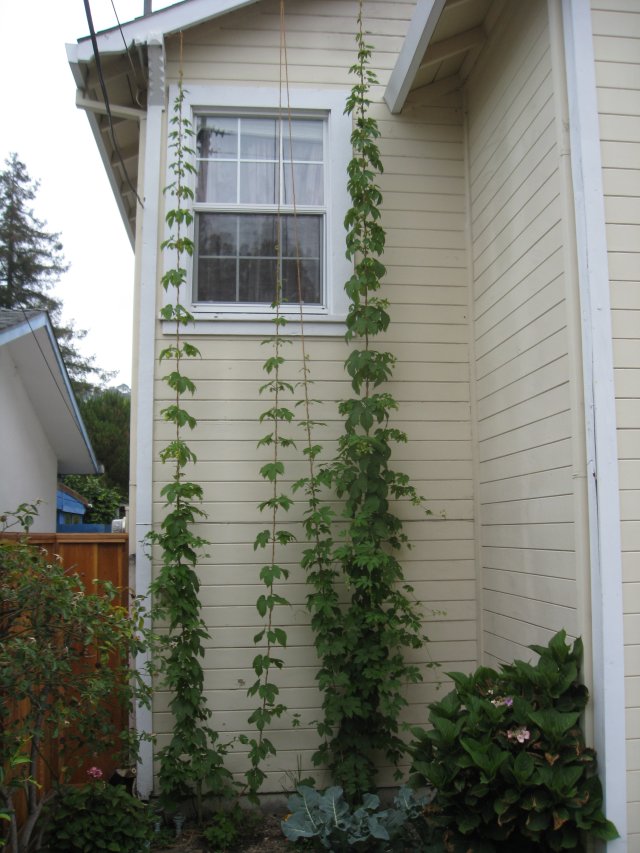boobookittyfuk wrote:Madtown Brew wrote:snip ... First of all, I doubt any of us planting hops this year will be able to generate a big enough rhizome by winter to divide it. ... snip
from what i have been led to believe is that at the end of the growing season, you cut the bine 1 foot from the ground and then bury it in soil all winter. In the spring you dig up the 1 foot of buried bine and it is now a rhizome.
... snip
I have done quite a bit of reading about hops, and I have never come across your suggested method; it is similar to the last method I will mention below, but yours is different if I am understanding you correctly. I have found four methods of propogation discussed in other places.
1. Rhizomes: the vast concensus seems to be that harvesting rhizomes (root cuttings from the crown) and planting them is the best method; it is the method used commercially, so that probably speaks for itself.
2. Seeds have been used by some, but they are out of the question in my opinion; you can't eliminate male plants, which usually are unwanted, and the seed will be hybrids (cross-species) rather than the genetically identical 'clones' which results from rhizomes -- which is what you probably want.
3. Cuttings that are rooted with the use of root-growth hormones have been successful, but this does not seem poplular -- probably because other methods work perhaps as well but without the need to purchase hormones.
4. Rooting of bines in the soil. This technique is different from what has been suggested because the bines are NOT cut until they are rooted, the rooting does not occur in the winter as suggested, but rather during the growing season, and the whole cutting is not buried. I am not suggesting that the original method won't work, but I will explain why I would expect the method I am describing now to work better. Hops are similar to tomato plants in that the vines/bines are capable of rooting when they are buried in the soil; if you will pull a branch of a tomato plant down to the ground, cover it with a bit of soil and put a rock on it to keep it buried, it will quickly develop roots where it is buried. Hops will do the same. The method reported in numerous places is to select a bine and bury some portion of the middle of it; it then remains connected to the crown, where it can derived water and nutrients, until it establishes sufficient roots. AFTER it is rooted, the length of bine which connects it and the original crown is then cut so that the new rooted bine now has an already established bine with leaves. This is done DURING the growing season so that it can continue to grow, enlarging its root system and storing the energy that it needs to make it through the winter. Now, some growers will do this after they harvest their cones, which shortens the time for developing roots, but there is a lot of vegetation to help provide energy for rooting along with the crown. Others prefer to select spare bines that they would end up trimming from their support anyway at the beginning of the season; in that way, the new plants have the entire season to develop a root system.
Personally, I have never done anything except plant and harvest rhizomes. In that respect, and in reply to 'Madtown Brew', let me post this experience. Last year was my first year to grow; I planted three varieties: Fuggles (did VERY well), Centennial (did poorly with very little cone production and bines probably less than 8'), and Magnum (did BADLY, with one rhizomes dying and the other growing to not much more than perhaps 3'). Despite the poor 'above-ground' growth of the latter, when I dug the crowns up to move them to a new location this past spring, I was surprised to find that the crowns of the two Centennial and one Magnum were nearly as large as the Fuggles (I cut the rootball for each of them down to about 1' x 3', rolled the balls into a wheelbarrow, spray-washed the soil off with a hose, and harvested rhizomes). After trimming some very nice-sized rhizomes to give away, I divided the crowns into 'super'-sized crowns by cutting them into three pieces each, and they are now growing well in their new locations. From my nine plants, I harvested 52 rhizomes which where shipped to our Grow-Hops free rhizome exchange (several hundred where given away). I live in Arkansas, by the way.
Grow-Hops(Yahoo) now has 2,174 members plus we have a .com presence where we are developing a Grow-Hops wiki, etc. For more info, please visit
www.tinyurl.com/29zr8r
Cheers.
Bill Velek





